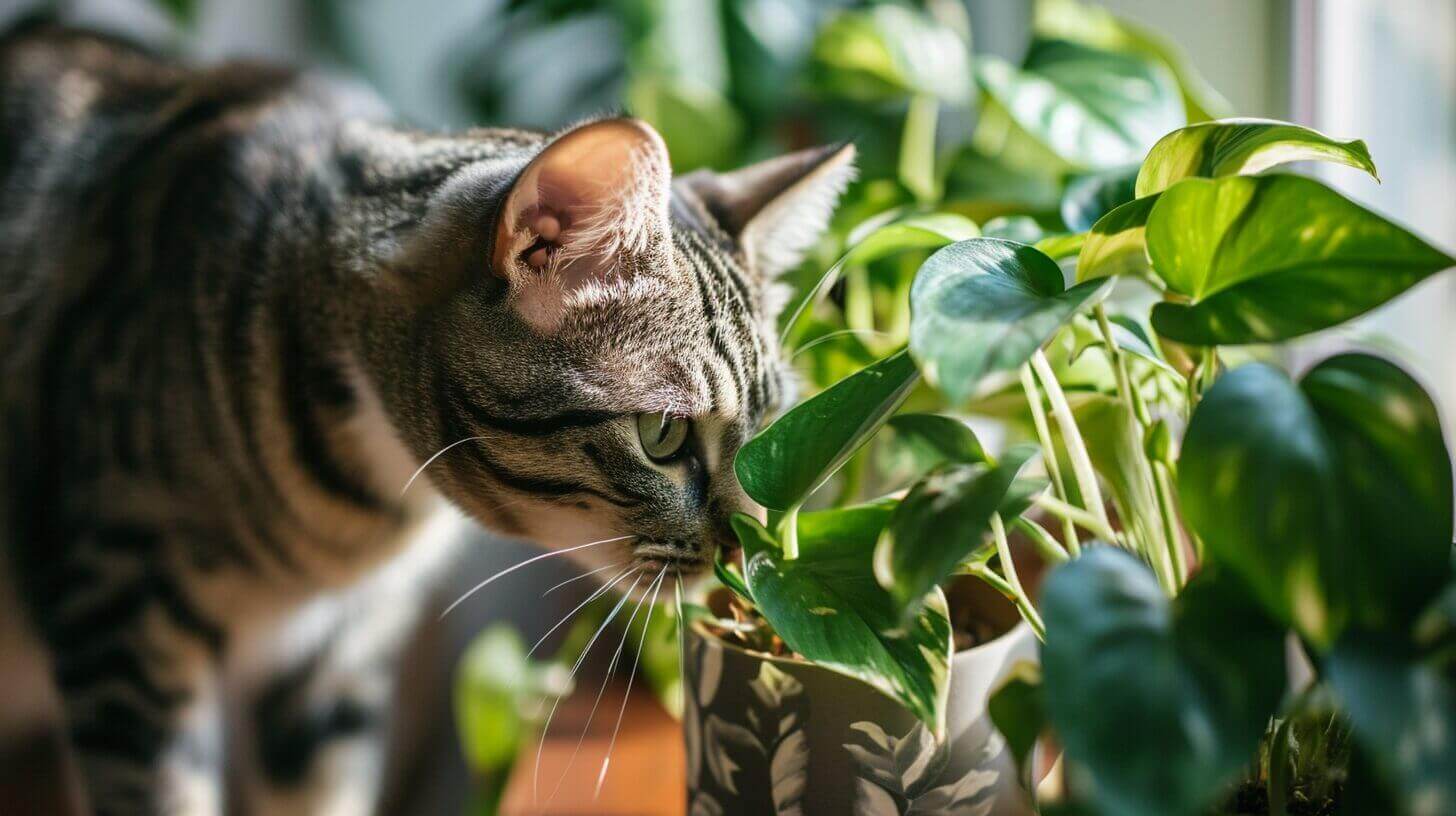Is Pothos Toxic to Cats? Pothos Plant Toxicity Ingestion Amounts and Safety Tips
In the complex tapestry of feline care, it is crucial for cat owners to be aware of potential hazards lurking within their homes.
One such hazard is the presence of pothos plants, which can pose a threat to our beloved feline companions.
This article aims to unravel the intricate web of knowledge surrounding the toxicity of pothos to cats, shedding light on ingestion amounts and offering invaluable safety tips for cat owners.
By equipping ourselves with this understanding, we can create a haven of safety and well-being for our cherished feline friends.
Key Takeaways
- Pothos ingestion can cause irritation and swelling in the mouth, throat, and digestive tract of cats.
- Cats may experience symptoms such as drooling, difficulty swallowing, vomiting, diarrhea, and difficulty breathing.
- Cats can vary in their sensitivity to pothos, and ingestion of large amounts can cause severe reactions.
- It is important to prevent cats from accessing pothos plants and to seek immediate veterinary treatment if ingestion or symptoms occur.
Toxic Compounds in Pothos: Understanding the Risks for Cats
The current discussion topic focuses on understanding the risks for cats associated with the toxic compounds found in Pothos. Pothos, also known as Devil’s Ivy, is a popular houseplant that is toxic to cats when ingested in large amounts. The plant contains insoluble calcium oxalate crystals, which can cause irritation and swelling in the mouth, throat, and digestive tract of cats.
Toxicity symptoms in cats include drooling, difficulty swallowing, vomiting, diarrhea, and in severe cases, difficulty breathing. If you suspect your cat has ingested Pothos or is exhibiting any of these symptoms, it is important to seek emergency veterinary treatment immediately. The vet may induce vomiting to remove any remaining plant material from the cat’s system and administer supportive care to alleviate symptoms.
Prevention is key in keeping cats safe from Pothos toxicity. It is advisable to keep Pothos plants out of reach of cats or opt for pet-friendly alternatives. Additionally, educating oneself about toxic houseplants and providing a safe environment for pets is crucial in preventing accidental ingestion.
Symptoms of Pothos Ingestion in Cats: What to Look Out For
Discussing the symptoms of Pothos ingestion in cats, it is important to be aware of the potential signs that may indicate toxicity and require immediate veterinary attention. Pothos, also known as Devil’s Ivy, is a common houseplant that can be toxic to cats when ingested. The symptoms of Pothos ingestion can vary depending on the amount ingested and the individual cat’s sensitivity to the plant’s toxic compounds.
To help cat owners identify potential complications associated with Pothos ingestion, here is a table summarizing the common symptoms:
| Symptoms | Description |
|---|---|
| Vomiting | Cats may experience frequent and persistent vomiting. |
| Diarrhea | Digestive upset and loose stools are common symptoms. |
| Oral irritation | Swelling, redness, and pain in the mouth may occur. |
| Difficulty | Cats may struggle to breathe properly due to throat swelling. |
| Breathing | Rapid or labored breathing can be a sign of severe toxicity. |
If a cat displays any of these symptoms after ingesting Pothos, it is crucial to seek immediate veterinary attention. Treatment options may include inducing vomiting, administering activated charcoal to absorb any remaining toxins, and providing supportive care to manage symptoms. In severe cases, hospitalization may be necessary for close monitoring and additional treatments.
Safe Levels of Pothos Exposure for Cats: How Much Is Too Much
Certainly, it is essential to determine the safe levels of Pothos exposure for cats and understand how much is considered excessive. Pothos, also known as Devil’s Ivy, is a popular houseplant that can be toxic to cats if ingested in large amounts. Here are three important factors to consider when it comes to the potential dangers of pothos exposure for cats:
Toxicity Levels: Pothos contains calcium oxalate crystals, which can cause irritation and inflammation in a cat’s mouth, throat, and digestive system. While small amounts of ingestion may only result in mild symptoms such as drooling or vomiting, larger amounts can lead to more severe reactions.
Sensitivity of Cats: It’s important to note that cats can vary in their sensitivity to pothos. Some cats may experience adverse effects even with minimal exposure, while others may not show any symptoms at all. It is always best to err on the side of caution and prevent cats from accessing pothos plants.
Safety Tips: To ensure the safety of your feline companion, consider the following tips: keep pothos plants out of reach, use deterrents such as bitter sprays or natural repellents, and provide alternative cat-friendly plants to satisfy their curiosity.
Treating Pothos Toxicity in Cats: Steps to Take in an Emergency
In cases of emergency involving pothos toxicity in cats, it is crucial to promptly take the necessary steps to mitigate the potential harm caused by ingestion. Pothos, also known as devil’s ivy, is a popular houseplant that can be toxic to cats if ingested. The plant contains insoluble calcium oxalate crystals, which can cause irritation and swelling in the mouth, throat, and digestive tract of cats.
If your cat has ingested pothos, it is important to act quickly. The first step is to remove any remaining plant material from your cat’s mouth or throat. You can use a damp cloth or gauze to gently wipe away any residue. Do not induce vomiting unless directed to do so by a veterinarian, as this can cause further damage.
Next, you should contact your veterinarian or an emergency animal hospital for further guidance. They may recommend bringing your cat in for a physical examination to assess the severity of the ingestion and provide appropriate treatment. This may include administering activated charcoal to help absorb any remaining toxins in the digestive system.
In the meantime, keep a close eye on your cat for any signs of distress or worsening symptoms. These may include drooling, difficulty swallowing, vomiting, or diarrhea. Providing a calm and quiet environment for your cat can help reduce stress and aid in their recovery.
Preventing Pothos Poisoning: Safety Tips for Cat Owners
To effectively prevent pothos poisoning in cats, it is essential for cat owners to implement safety measures and adhere to guidelines provided by veterinarians. Pothos, also known as Devil’s Ivy, is a popular houseplant that can be toxic to cats if ingested.
Here are three important tips for cat owners to prevent pothos poisoning and keep their feline friends safe:
Cat proofing houseplants: Place pothos and other toxic plants out of reach of your cats. Consider hanging them from the ceiling or using elevated shelves. Alternatively, use barriers such as baby gates or pet enclosures to restrict access to certain areas of the house.
Identify alternative pet-friendly houseplants: There are many beautiful and non-toxic houseplants that can be a safe alternative to pothos. Some examples include spider plants, Boston ferns, and African violets. Research and consult with your veterinarian to find the best options for your home.
Provide adequate stimulation and enrichment: Cats may be attracted to houseplants out of boredom or curiosity. Ensure your cat has plenty of toys, scratching posts, and interactive playtime to keep them entertained and less likely to explore potentially toxic plants.
How Much Pothos Ingestion Causes Poisoning in Cats? Leaf Amounts and Dangers
Pothos plants contain insoluble calcium oxalates that can cause toxicity if ingested by cats. Here’s a quick overview of pothos poisoning in cats. Golden pothos is definitely toxic to cats if ingested. Here’s an overview of how much can lead to poisoning:
The toxic component in golden pothos is insoluble calcium oxalate crystals found in the leaves, stems, and rhizomes.
As few as 1-2 leaves ingested can cause minor symptoms like drooling and swollen tongue.
Larger ingestions of 5-10 leaves may cause more severe symptoms including:
- Vomiting
- Difficulty swallowing
- Decreased appetite
- Lethargy
Significant ingestions of 20+ leaves are most likely to cause potentially life-threatening poisoning that requires hospitalization.
The size of the cat also plays a role. Small kittens are at higher risk for poisoning effects than larger adult cats.
Estimated toxic doses according to cat’s weight:
- Up to 5 lbs: 2-3 leaves
- 5-10 lbs: 3-5 leaves
- 10-15 lbs: 5-7 leaves
- Over 15 lbs: 8+ leaves
Treatment involves removing plant material, medications to treat swelling and pain, and supportive care. Hospitalization may be required.
FAQ – pothos poisoning in cats
Can Cats Safely Chew on Pothos Leaves Without Any Negative Effects?
Cats are known for their curious nature and tendency to chew on plants. While it is important to ensure the safety of our feline companions, not all houseplants are safe for them to ingest.
When considering cat behavior and safe houseplants for cats, it is crucial to research and understand the potential effects of specific plants. This includes examining whether cats can safely chew on pothos leaves without any negative effects.
When Should I Prune My Pothos Plant to Ensure Safety for My Cats?
To ensure safety for your cats, pruning pothos for healthier growth is recommended. Regularly trim overgrown vines and remove any dead or decaying leaves. This will not only maintain the plant’s shape but also prevent your curious feline friends from ingesting toxic parts. For optimal results, conduct pruning when the plant shows signs of sluggish growth or before the growing season begins.
Are All Varieties of Pothos Equally Toxic to Cats?
Different varieties of pothos can vary in their toxicity to cats. While all pothos plants contain calcium oxalate crystals, which can cause irritation and discomfort when ingested, some varieties may have higher concentrations of these compounds.
It is crucial to understand the potential effects of pothos ingestion on other pets, such as dogs, and to consider alternative pet-friendly plants that can be safely enjoyed by cats.
Conducting further research and consulting with a veterinarian can provide more detailed information on this topic.
How Long Does It Take for Symptoms to Appear After a Cat Ingests Pothos?
The time to onset of symptoms and common signs of pothos ingestion in cats can vary depending on factors such as the amount ingested and the individual cat’s sensitivity. Symptoms may appear within a few hours or up to a few days after ingestion.
Common signs include vomiting, diarrhea, drooling, lethargy, and loss of appetite.
It’s important to monitor cats closely and seek veterinary care if any concerning symptoms arise.
Can Pothos Toxicity in Cats Be Fatal if Left Untreated?
Pothos toxicity in cats can be reversible if treated promptly and appropriately. However, if left untreated, it has the potential to be fatal. Common symptoms of pothos toxicity in cats include vomiting, diarrhea, drooling, and difficulty breathing.
It is important to seek immediate veterinary care if you suspect your cat has ingested pothos. Remember, prevention is key in ensuring the safety of your feline companion, so it is best to keep pothos plants out of their reach.
Are There Any Long-Term Health Effects for Cats Who Have Ingested Pothos?
Long-term health effects of cats ingesting Pothos may vary depending on the amount consumed and individual factors. Pothos contains calcium oxalate crystals, which can cause oral irritation, drooling, and difficulty swallowing. In severe cases, it may lead to gastrointestinal upset. However, there is limited research on the long-term effects of Pothos ingestion in cats.
It is crucial to prevent access to Pothos and seek immediate veterinary care if ingestion occurs to minimize potential harm and ensure the well-being of the cat.
Q: What are the symptoms of golden pothos poisoning in cats?
A: The symptoms of golden pothos poisoning in cats may include drooling, vomiting, difficulty swallowing, oral irritation, and swelling of the tongue.
Q: Are all types of pothos plants toxic to cats?
A: Yes, all types of pothos plants, including golden pothos and neon pothos, are considered toxic to cats.
Q: What part of the pothos plant is toxic to cats?
A: The entire pothos plant, including the leaves, stems, and sap, contains calcium oxalate crystals that can be toxic to cats.
Q: How much pothos plant ingestion is considered dangerous for cats?
A: Even a small amount of pothos plant ingestion can be dangerous for cats, as the toxins in the plant can cause adverse reactions.
Q: What should I do if my cat ingests a pothos plant?
A: If your cat ingests a pothos plant, it is important to seek immediate veterinary attention. Contact your veterinarian or emergency animal clinic for guidance.
Q: How can I keep my cats safe from pothos plants?
A: To keep your cats safe from pothos plants, it is best to keep the plants out of their reach or avoid having them in your home altogether.
Q: Are pothos plants toxic to dogs as well?
A: Yes, pothos plants are toxic to both cats and dogs.
Can Pothos Plants Be Harmful to Cats if They Are Not Getting Enough Light?
Can Pothos plants harm cats if they don’t receive enough light? Light for Pothos is vital for their survival, but it poses no direct harm to cats. Although these plants are considered mildly toxic to pets, any potential harm is unrelated to light deprivation. Providing adequate lighting and ensuring your furry friend cannot access the plant is essential for a safe and healthy home environment.
Q: Can I still have a pothos plant in my home if I have cats?
A: It is generally not recommended to have a pothos plant in your home if you have cats, as the plant can pose a risk to their health.
Q: What should I do if I suspect my cat has been poisoned by a pothos plant?
A: If you suspect your cat has been poisoned by a pothos plant, it is important to take your cat to the vet as soon as possible for proper diagnosis and treatment.







